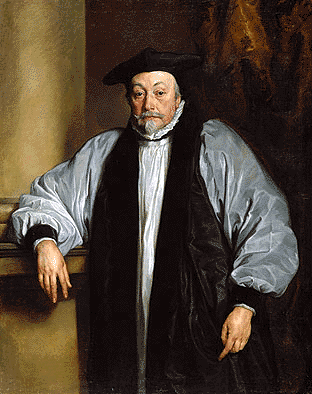 Like Hooker (and John Cotton) before him, Shepard was driven from the pulpit by Archbishop Laud and his pursuit of religious conformity. (Laud is pictured in Sir Anthony Van Dyck's 1635 portrait.) After travelling to the New World, he succeeded Thomas Hooker as minister in Cambridge after Hooker took his congregation west to Connecticut. Shepard played a key role in the suppression of Anne Hutchinson during the Antinomian Crisis in Massachusetts and was considered a rising star among the ministry at his untimely death at the age of 43. Several of his sons followed their father into the ministry, including Thomas Shepard, Jr., whose "Eye-Salve" is considered a major late 17th century New England sermon.
Like Hooker (and John Cotton) before him, Shepard was driven from the pulpit by Archbishop Laud and his pursuit of religious conformity. (Laud is pictured in Sir Anthony Van Dyck's 1635 portrait.) After travelling to the New World, he succeeded Thomas Hooker as minister in Cambridge after Hooker took his congregation west to Connecticut. Shepard played a key role in the suppression of Anne Hutchinson during the Antinomian Crisis in Massachusetts and was considered a rising star among the ministry at his untimely death at the age of 43. Several of his sons followed their father into the ministry, including Thomas Shepard, Jr., whose "Eye-Salve" is considered a major late 17th century New England sermon.As you read, consider how Bunyan's life experiences and eventual conversion compare with Shepard's. Additionally, how do their spiritual experiences compare to Shepard's less educated congregants?
No comments:
Post a Comment